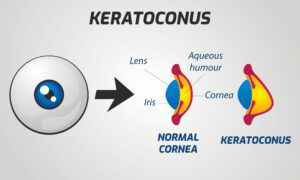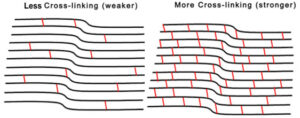Corneal cross-linking (CXL) is an advanced treatment for keratoconus. This FDA-approved procedure uses a combination of vitamin B2 (riboflavin) and UV (ultraviolet) light to strengthen the cornea. Keep reading to learn more about corneal cross-linking.
What is Keratoconus?

Keratoconus is a disease of the cornea that causes the tissue to thin, become weaker, and slowly bulge outward into a cone shape. This abnormal shape of the cornea can cause significant blurring of vision.
Some of the signs and symptoms of keratoconus include:
- Blurry vision
- Increased sensitivity to light
- Eye irritation
- Eye pain
- Headaches
- Multiple ghost images
People with keratoconus may notice that their vision becomes distorted, making it more challenging to do tasks like reading or driving. The eye condition may develop in your late teens to early twenties, with symptoms gradually worsening over ten to twenty years.
How Does Corneal Cross-Linking Correct Keratoconus?
A normal cornea has cross-links between its collagen fibers. These cross-links keep the cornea stable and prevent it from developing an irregular shape.
When a cornea has keratoconus, it is structurally weaker. Corneal cross-linking can help this condition by creating more bonds or cross-links within the cornea thus making it stiffer and stronger.

This minimally-invasive procedure is performed by a dedicated ophthalmologist at Evergreen Eye Center. During treatment, your ophthalmologist will apply riboflavin drops to your eye before shining an ultraviolet light onto the cornea. This combination of riboflavin soaking and UV energy exposure creates a chemical reaction in the cornea that increases the cross-links between the collagen fibers. This creates a more stable and stronger cornea that is resistant to further distortion caused by keratoconus.
The procedure is successful in more than 90 percent of patients. However, corneal cross-linking treatment can’t reverse the damage already caused by keratoconus, so it is important to treat it early in the course of the disease.
Can Anyone Have Corneal Cross-Linking?
Corneal cross-linking is the most effective procedure for slowing or stopping the progression of mild to moderate keratoconus. But if the condition is too advanced, your cornea will be too scarred or thin for CXL to work.
Corneal cross-linking also can’t be performed on patients:
- Who have uncontrolled eye allergies
- If they have corneal infections from the herpes simplex virus
- Who are pregnant
What to Expect After Corneal Cross-Linking

Following treatment, your ophthalmologist will leave the soft bandage contact lens in your eye until the surface heals appropriately. For most patients, this can take anywhere between 4 to 7 days.
The anesthetic eye drops you’re given will wear off the same day, which may leave you with some discomfort. It’s not unusual to have red, gritty eyes that feel uncomfortable and are sensitive to light for a few days after having corneal cross-linking.
Each patient is different, so this may vary. Once you’ve had corneal cross-linking, your vision may be blurry, but it will start to get clearer after several weeks.
Although everyday activities like reading, using the computer, or watching TV won’t damage your eyes as you heal, you may find it a lot more comfortable to rest with your eyes shut.
Taking Care of Your Eyes After a Corneal Cross-Linking Procedure
Because having corneal cross-linking is still considered a procedure, it’s necessary to take your recovery seriously. Arrange for someone to drive you home on the day that you have corneal cross-linking.
You won’t be allowed to drive until your ophthalmologist clears you at a later time. You’ll be given drops to apply at least four times daily for the first week. It’s crucial to put the drops in precisely as prescribed to help your eyes heal.
You can exercise lightly 2 to 3 days after your procedure, but you shouldn’t use the hot tub, swim, or get water in your eyes for 7-10 days after having corneal cross-linking. Your eyes are much more susceptible to bacteria and infection while they continue healing.
It’s essential to attend all your follow-up appointments to ensure the surface of your eye is healing properly.
Possible Complications of Having Corneal Cross-Linking
Crosslinking is very safe. However, as is possible with all surgical procedures, it comes with some risks:
- Less than 1 percent of patients develop an infection after CXL
- Corneal haze is very common after crosslinking but usually fades over several months. In some cases, the haze can be more persistent and can cause a decrease in vision.
- In less than 10% of cases, keratoconus can continue to progress despite crosslinking. Eye rubbing can be a contributing factor to keratoconus progression, so it is important to refrain from eye rubbing whether you have crosslinking or not.
Corneal Crosslinking at Evergreen Eye Center
Evergreen Eye Center is one of the few practices in Puget Sound that specializes in corneal cross-linking. Our ophthalmologists use only FDA-approved corneal crosslinking technologies to give patients the best chance to avoid further deterioration of vision from keratoconus.

While corneal cross-linking is highly effective in treating keratoconus, not everyone qualifies for the procedure. Find out if corneal cross-linking may be the right treatment for you by scheduling an appointment at Evergreen Eye Center today!

